Chapter 5 Validation
Validation is the process to evaluate the performance of merged data produced with CDT, satellite rainfall estimates products and the output of climate models, and to evaluate the skill of a specific methods or parameters used for the bias adjustment or the merging. Generally, statistics are computed to evaluate the accuracy of the estimated data. These statistics can be classified into 3 groups: continuous, categorical and volumetric. The following table shows the list of all computed statistics by CDT.
Abbreviation name |
Long name |
Perfect score |
Statistics Group |
Documentation |
|
|---|---|---|---|---|---|
| CORR | Correlation | 1 | Continuous | Forecast verification | |
| BR2 | Coefficient of determination (R2) multiplied by the regression slope | 1 | Continuous | Package hydroGOF | |
| BIAS | Bias | 1 | Continuous | Forecast verification | |
| PBIAS | Percent Bias | 0 | Continuous | Forecast verification | |
| ME | Mean Error | 0 | Continuous | Forecast verification | |
| MAE | Mean Absolute Error | 0 | Continuous | Forecast verification | |
| RMSE | Root Mean Square Error | 0 | Continuous | Forecast verification | |
| NSE | Nash-Sutcliffe Efficiency | 1 | Continuous | Forecast verification | |
| MNSE | Modified Nash-Sutcliffe efficiency | 1 | Continuous | Package hydroGOF | |
| RNSE | Relative Nash-Sutcliffe efficiency | 1 | Continuous | Package hydroGOF | |
| IOA | Index of Agreement | 1 | Continuous | Package hydroGOF | |
| MIOA | Modified index of agreement | 1 | Continuous | Package hydroGOF | |
| RIOA | Relative Index of Agreement | 1 | Continuous | Package hydroGOF | |
| POD | Probability Of Detection | 1 | Categorical | Forecast verification | |
| POFD | Probability Of False Detection | 0 | Categorical | Forecast verification | |
| FAR | False Alarm Ratio | 0 | Categorical | Forecast verification | |
| FBS | Frequency Bias (Bias score) | 1 | Categorical | Forecast verification | |
| CSI | Critical Success Index | 1 | Categorical | Forecast verification | |
| HSS | Heidke Skill Score | 1 | Categorical | Forecast verification | |
| MQB | Mean Quantile Bias | 1 | Volumetric | (Aghakouchak et al., 2011) and (Aghakouchak & Mehran, 2013) | |
| MQE | Mean Quantile Error | 0 | Volumetric | (Aghakouchak et al., 2011) and (Aghakouchak & Mehran, 2013) | |
| QPOD | Quantile Probability of Detection | 1 | Volumetric | (Aghakouchak et al., 2011) and (Aghakouchak & Mehran, 2013) | |
| VFAR | Volumetric False Alarm Ratio | 0 | Volumetric | (Aghakouchak et al., 2011) and (Aghakouchak & Mehran, 2013) | |
| QFAR | Quantile False Alarm Ratio | 0 | Volumetric | (Aghakouchak et al., 2011) and (Aghakouchak & Mehran, 2013) | |
| VMI | Volumetric Miss Index | 0 | Volumetric | (Aghakouchak et al., 2011) and (Aghakouchak & Mehran, 2013) | |
| QMISS | Quantile Miss Index | 0 | Volumetric | (Aghakouchak et al., 2011) and (Aghakouchak & Mehran, 2013) | |
| VCSI | Volumetric Critical Success Index | 1 | Volumetric | (Aghakouchak et al., 2011) and (Aghakouchak & Mehran, 2013) | |
| VCSI | Volumetric Critical Success Index | 1 | Volumetric | (Aghakouchak et al., 2011) and (Aghakouchak & Mehran, 2013) | |
| QCSI | Quantile Critical Success Index | 1 | Volumetric | (Aghakouchak et al., 2011) and (Aghakouchak & Mehran, 2013) |
CDT has the facilities to validate gridded data or point data against the observation data or station data. Using validation functionality of CDT, users can validate spatial points data in CDT format, gridded data in netCDF format or even validate multiple datasets at once.
5.1 Spatial Points Data (CDT Format)
This feature allows you to validate satellite/gridded data extracted at station locations against station data. This can be done for both precipitation and temperature data.
5.1.1 Precipitation data
The step-by-step process to validate precipitation data is described below.
Use the menu Validation -> Spatial Points Data (CDT Format) -> Precipitation Data to validate precipitation data of satellite or gridded data converted into CDT format. This will open a tabbed widget in the left.
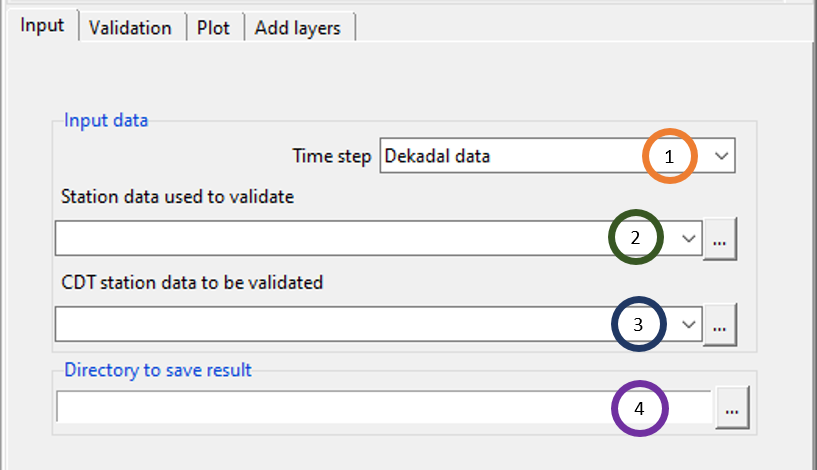
- Select the time step of the data by clicking on the dropdown.
- Select the station precipitation data using which you want to validate some other precipitation data.
- Use the field CDT station data to be validated to select the satellite/gridded data extracted at the station locations that you want to validate. For example, if you want to validate CHIRPS data for Kenya against rainfall data, then you need to extract CHIRP data at station locations for Kenya and then use that file here.
- Specify the directory where you want to save the result.
Now, click on the Validation tab to perform validation by specifying different options for validation.
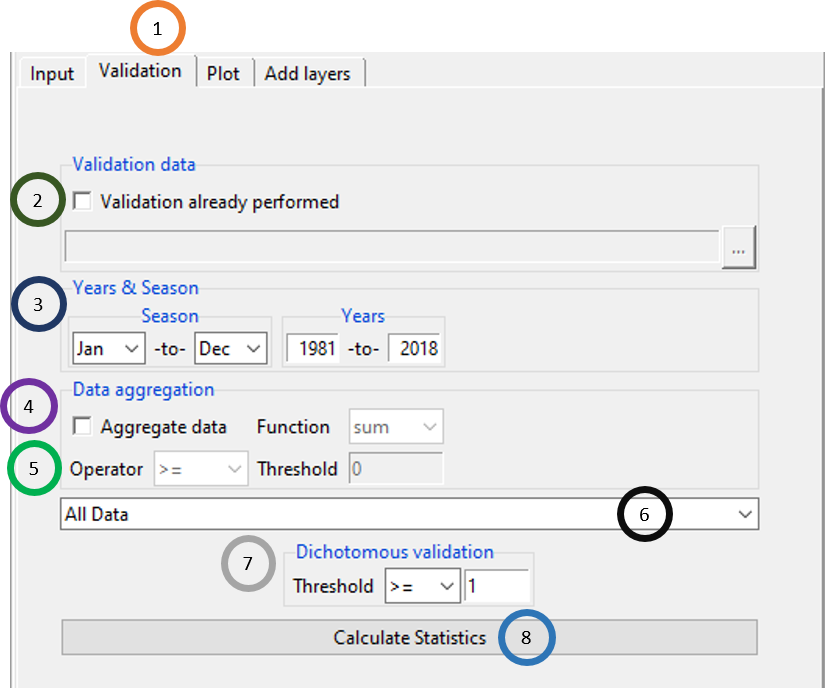
- Click on the tab Validation.
- If validation was already performed in a previous session, then you can use that instead of performing a new validation. For that, tick the box to the left of Validation already performed. Using
 , browse to the .Rds file containing the validation data.
, browse to the .Rds file containing the validation data. - Select the time period by selecting the month and year ranges. For example, if you want to validate gridded data for rainfall season, then select the months corresponding to rainy season and the years for which you want to validate.
- You can also aggregate data by ticking the Aggregate data field and selecting any of the two functions sum and mean under Function. For example, if you want to validate total rainfall for the rainy season, select the function sum and if you want to validate the average rainfall, select mean.
- If you selected count, Operator and Threshold fields will be activated.
- This allows to calculate validation either for All Data, or for Spatial Average, or for Per Station. For All Data, validation is performed by considering all the data, for Spatial Average, validation is performed by aggregating data on a single date for all stations and then computing validation, for Per Station, validation is done separately for all stations.
- Dichotomous validation allows you to look at the amount of rainfall below or above which you want to validate the rainfall. For example, if you want to validate gridded data for extreme rainfall such as an amount of 200mm rainfall or above, specify >= and 200 in the fields right to Threshold.
- Click on Calculate Statistics to calculate the validation statistics.
Using the Plot tab, you can plot the validation and view the result in tabular format.
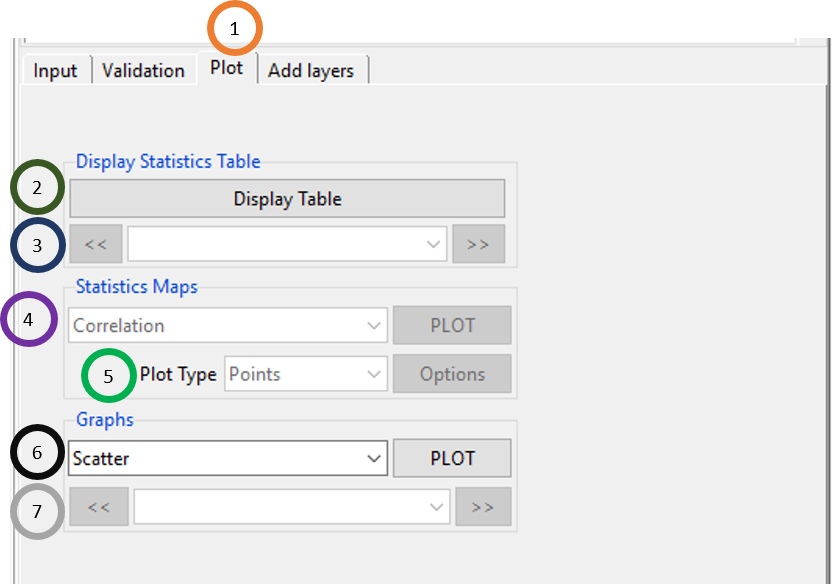
- Click on the Plot tab.
- Click on Display Table to look at the validation statistics arranged in a table. If you selected All Data or Spatial Average in step 6 of the validation tab, then you will see validation statistics where only one statistic is reported and if you selected Per station, then every statistic will be reported for each of the stations.
- If you selected Per station in step 6 of the validation tab, then using
 and
and  , you can look at validation statistics for different stations.
, you can look at validation statistics for different stations. - Again, if you selected Per station in step 6 of the validation tab, then this field will be activated and it lists all the validation statistics. Clicking on PLOT will plot a map of the selected statistic.
- Click on Plot Type to select the plot type which is either Points or Pixels. Clicking on Options, you can change the format of the color.
- Scatter and CDF graphs are available for all the three options (step 6 of the Validation tab) for validation and Per station has additional option of Lines chart.
- For Per station, this field is activated and you can use
 and
and  to look at the selected graph for different stations.
to look at the selected graph for different stations.
Using Add layers tab, you can add shapefile to your validation maps.
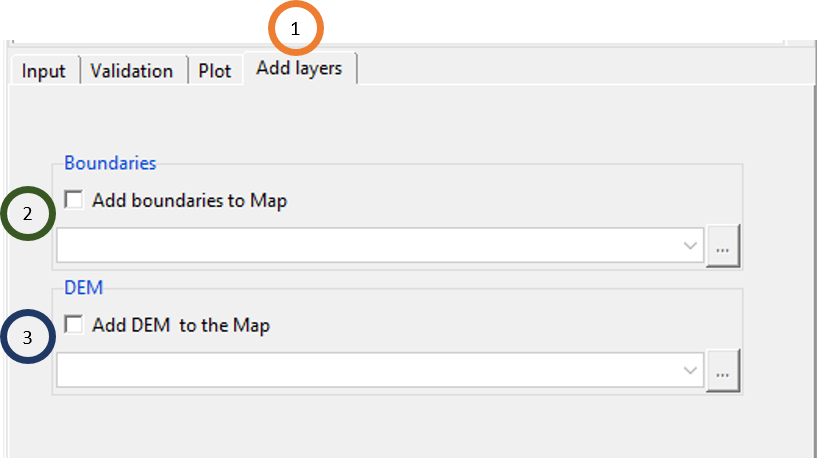
- To add map, tick Add boundaries to Map and then load the shapefile.
- You can also add DEM by ticking Add DEM to the Map and then by loading the DEM.
5.1.2 Temperature data
Similar to precipitation, users can perform all the aforementioned validation tasks using the menu Validation -> Spatial Points Data (CDT Format) -> Precipitation Data.
5.2 Gridded Data (NetCDF Format)
This feature allows you to validate satellite/gridded data against station data where you can extract gridded data at the station locations inside this feature. Thus if you have NetCDF data of rainfall or temperature data (NetCDF) coming from satellite or reanalysis data, you can use this feature to validate the gridded data using this feature.
5.2.1 Precipitation data
Use the menu Validation -> Gridded Data (NetCDF Format) -> Precipitation Data to validate precipitation data of satellite or gridded data in NetCDF format where the extraction of gridded data at station location is done using an additional tab available for this feature. This will open a tabbed widget in the left.
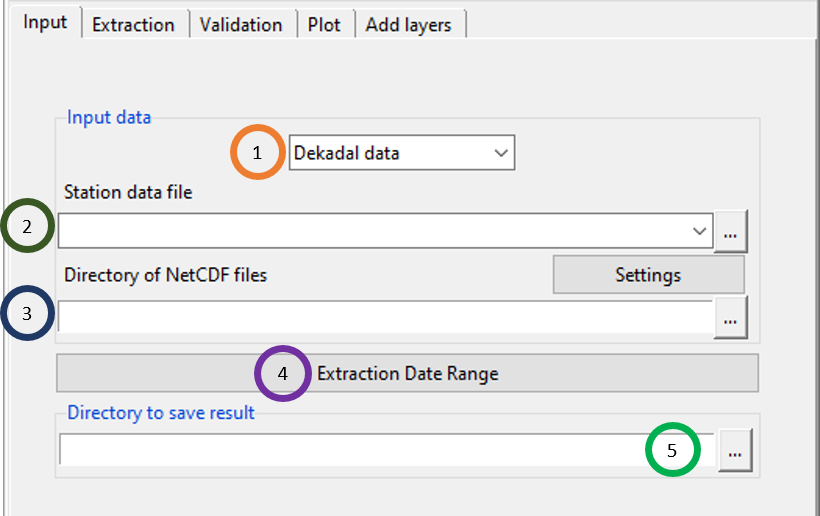
- Specify the time step of the data.
- Specify the station data file by browsing to or loading it.
- Specify the directory that contains the NetCDF files corresponding to the precipitation data that you want to validate.
- Provide the date range for which you want to extract data from the NetCDF files. This is the time range for which you want to validate the gridded precipitation data (in NetCDF format).
- Browse to the directory where you want to save the result.
Using Extraction tab, you can extract NetCDF data at station locations.
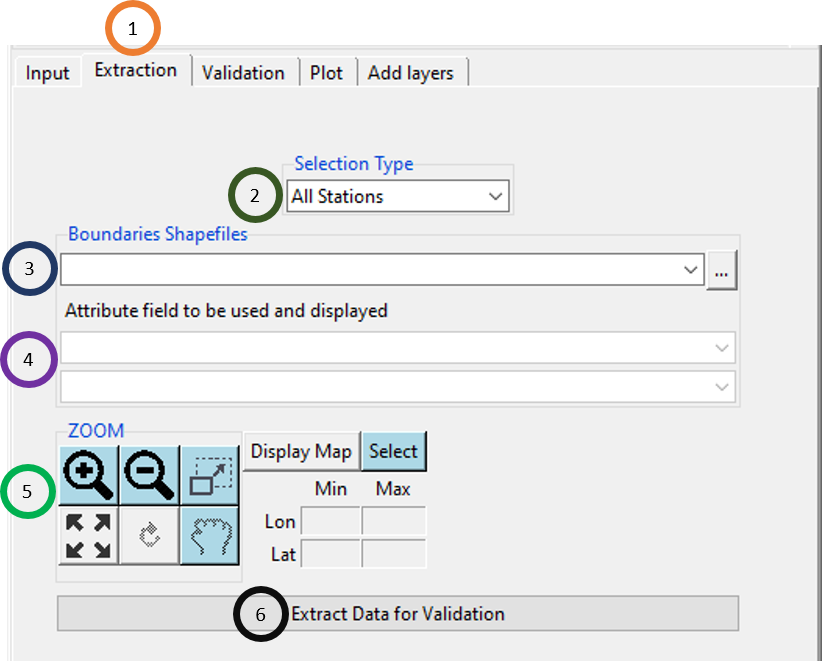
- Click on the Extraction tab.
- You can specify the way you want to extract from the NetCDF files by clicking on three different options under Selection Type field. If you selected All Stations, then coordinates of all station locations will be used to extract the data. If you selected Rectangle, then you can draw a rectangle over the map that will be shown in the output section (adding shapefile is to be done in the next step). The other two options are: Rectangle and Polygons where the former one allows you to extract data from the NetCDF file by specifying a rectangle and the latter allows you to extract by a polygon of the shapefile specified by you.
- Add the shapefile by selecting from the dropdown or by browsing to it.
- In step 2, if you selected Polygons under Selection Type, then the two fields under Attribute field to be used and displayed will be activated. For the first field, you can select the attribute field that you want to use for selecting polygon. For the second field, you can write a name that will be displayed.
- You can zoom in
 , zoom out
, zoom out  , select zoom area
, select zoom area  , reset zoom
, reset zoom  , redraw map
, redraw map  , or move the map
, or move the map  . If you click Display Map, then the map will be displayed in the Output section in the right. If you selected Polygons in step 2, click on Select to select the polygon you want to select from the map. If you selected Rectangle in step 2, then specify the minimum and maximum of the longitude and latitude to specify the rectangle coordinates.
. If you click Display Map, then the map will be displayed in the Output section in the right. If you selected Polygons in step 2, click on Select to select the polygon you want to select from the map. If you selected Rectangle in step 2, then specify the minimum and maximum of the longitude and latitude to specify the rectangle coordinates. - Click on Extract Data for Validation to extract data from the NetCDF files according to the specifications provided here.
Using Validation tab, you can specify the time period of the validation and the way validation is to be performed.
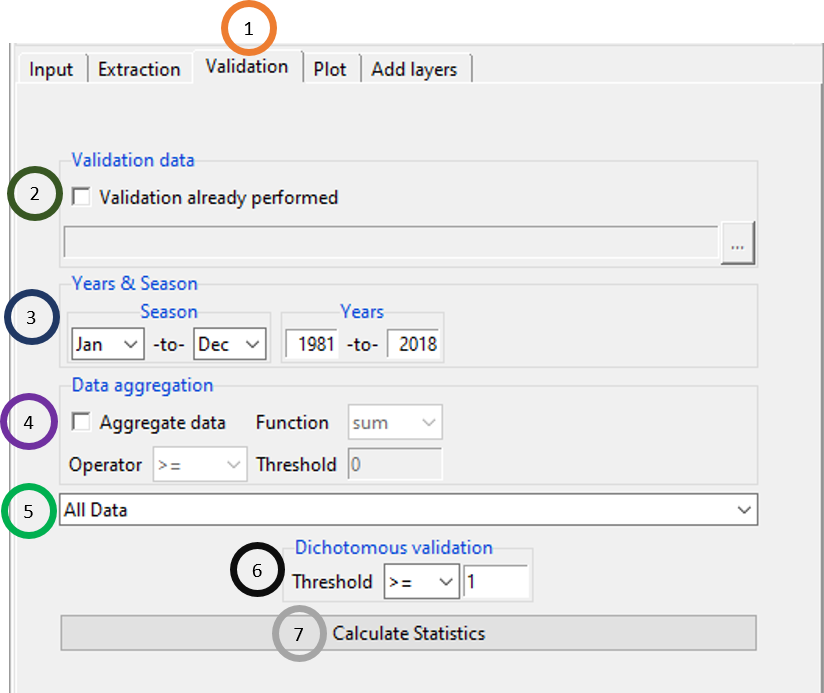
- Click on the Validation tab.
- If validation was performed before, tick the field Validation already performed and select the .Rds file corresponding to the validation.
- Select the time period by specifying the Season and Years.
- Tick on Aggregate data to aggregate data either by mean, or sum, or count. If you selected count, Operator and Threshold fields will be activated.
- This allows to calculate validation either for All Data, or for Spatial Average, or for Per Station. For All Data, validation is performed by considering all the data, for Spatial Average, validation is performed by aggregating data on a single date for all stations and then computing validation, for Per Station, validation is done separately for all stations.
- Dichotomous validation allows you to look at the amount of rainfall below or above which you want to validate the rainfall.
- Click on Calculate Statistics to calculate the validation statistics.
Using Plot tab, you can plot the validation and view the result in tabular format.
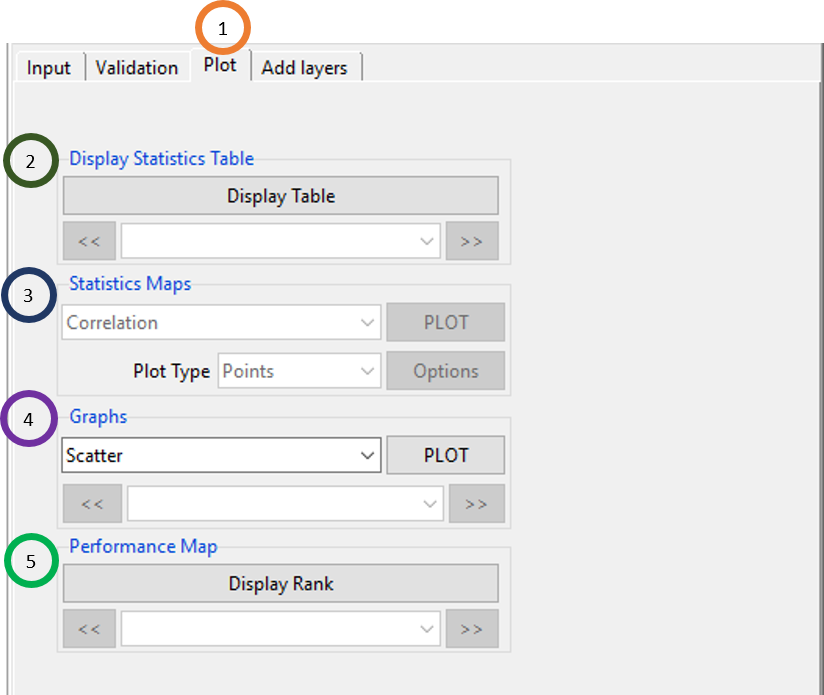
- Click on the Plot tab.
- Click on Display Table to look at the validation statistics arranged in a table. If you selected All Data or Spatial Average in step 6 of the validation tab, then you will see validation statistics where only one statistic is reported and if you selected Per station, then every statistic will be reported for each of the stations.
- If you selected Per station in step 6 of the validation tab, then using
 and
and  , you can look at validation statistics for different stations.
, you can look at validation statistics for different stations. - Again, if you selected Per station in step 6 of the validation tab, then this field will be activated and it lists all the validation statistics. Clicking on PLOT will plot a map of the selected statistic.
- Click on Plot Type to select the plot type which is either Points or Pixels. Clicking on Options, you can change the format of the color.
- Scatter and CDF graphs are available for all the three options (step 6 of the Validation tab) for validation and Per station has additional option of Lines chart.
- For Per station, this field is activated and you can use
 and
and  to look at the selected graph for different stations.
to look at the selected graph for different stations.
Using Add layers tab, you can add shapefile to your validation maps.
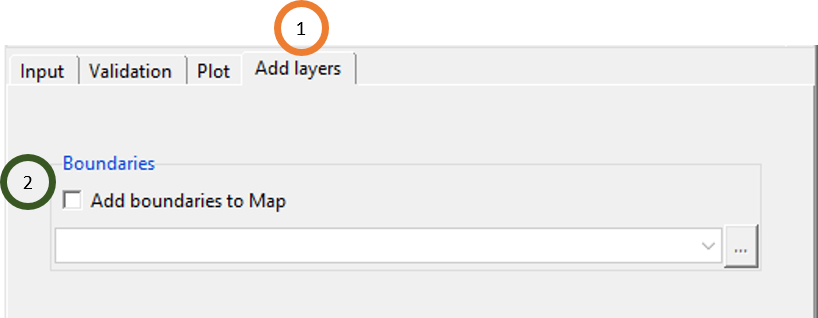
- To add map, tick Add boundaries to Map and then load the shapefile.
- You can also add DEM by ticking Add DEM to the Map and then by loading the DEM.
5.3 Validate multiple data sets
This is similar to Spatial Points Data (CDT Format), the only difference is that using Validate multiple data sets, you can validate multiple data products. Suppose you want to validate CHIRP, CHIRPS, TAMSAT and TRMM against the station data of Kenya. Using this feature, you can do this. Under this feature, CDT allows you to validate multiple precipitation and temperature products.
5.3.1 Precipitation Data
Use the menu Validation -> Validate multiple data sets -> Precipitation Data to validate multiple data sets of precipitation data. This will open a tabbed widget in the left.
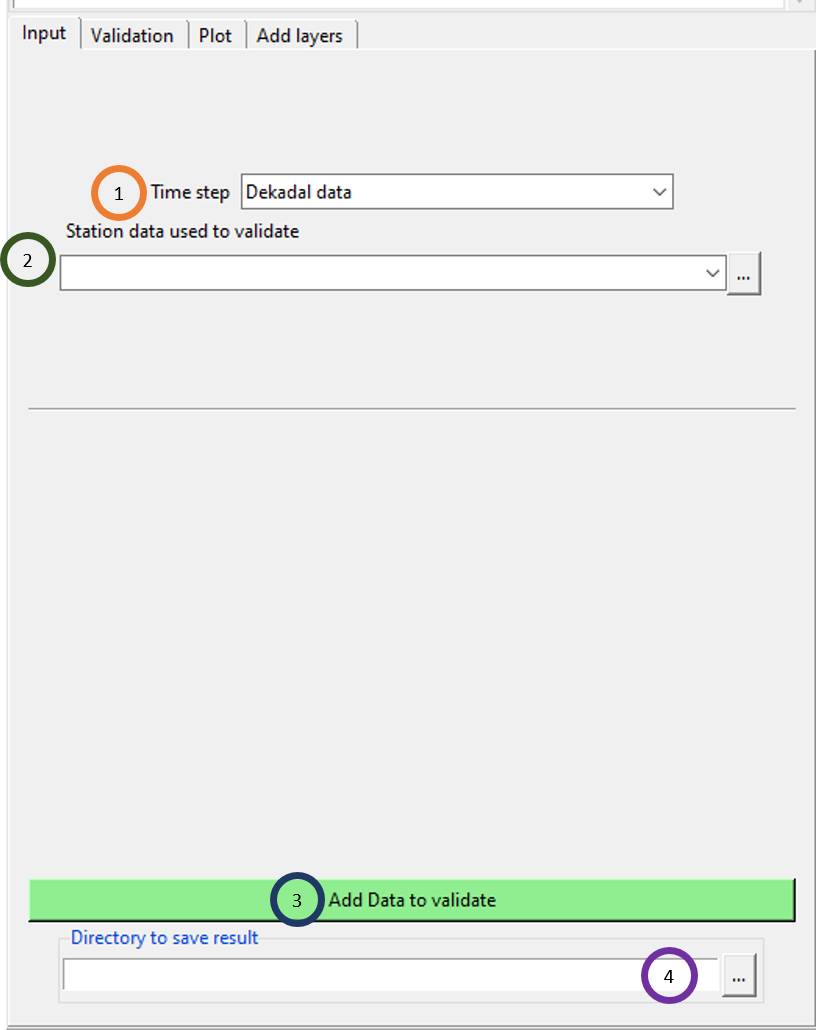
Select the time step of the data.
Select or browse to the station data using which you want to validate multiple data sets.
Click on Add Data to validate to add data set one by one. Once you click this field, you will see that an option is added in this widget to add a new dataset. Every time you click this field, you will see a new field added to add another data set.
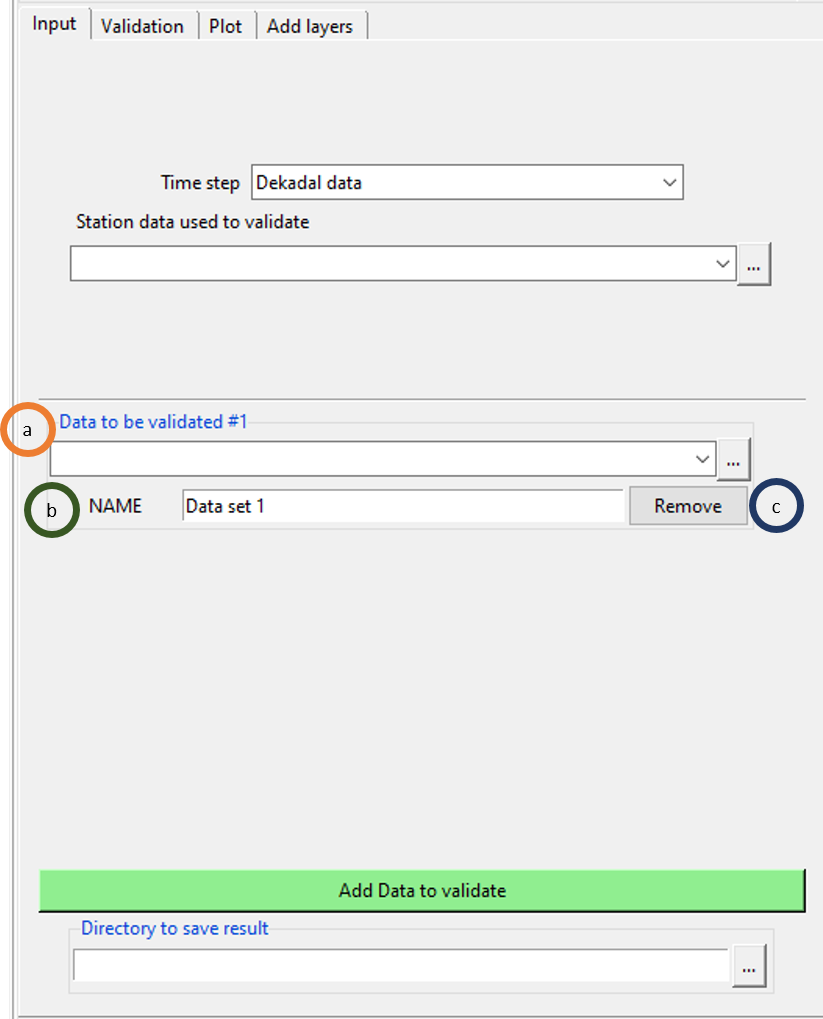
- A new field is added and you can browse to the first data set using this field.
- You can give it a name to this dataset.
- If you click Remove, then all the fields under Data to be validated #1 will be removed.
If you again click on Add Data to validate, then similarly another field will be added.
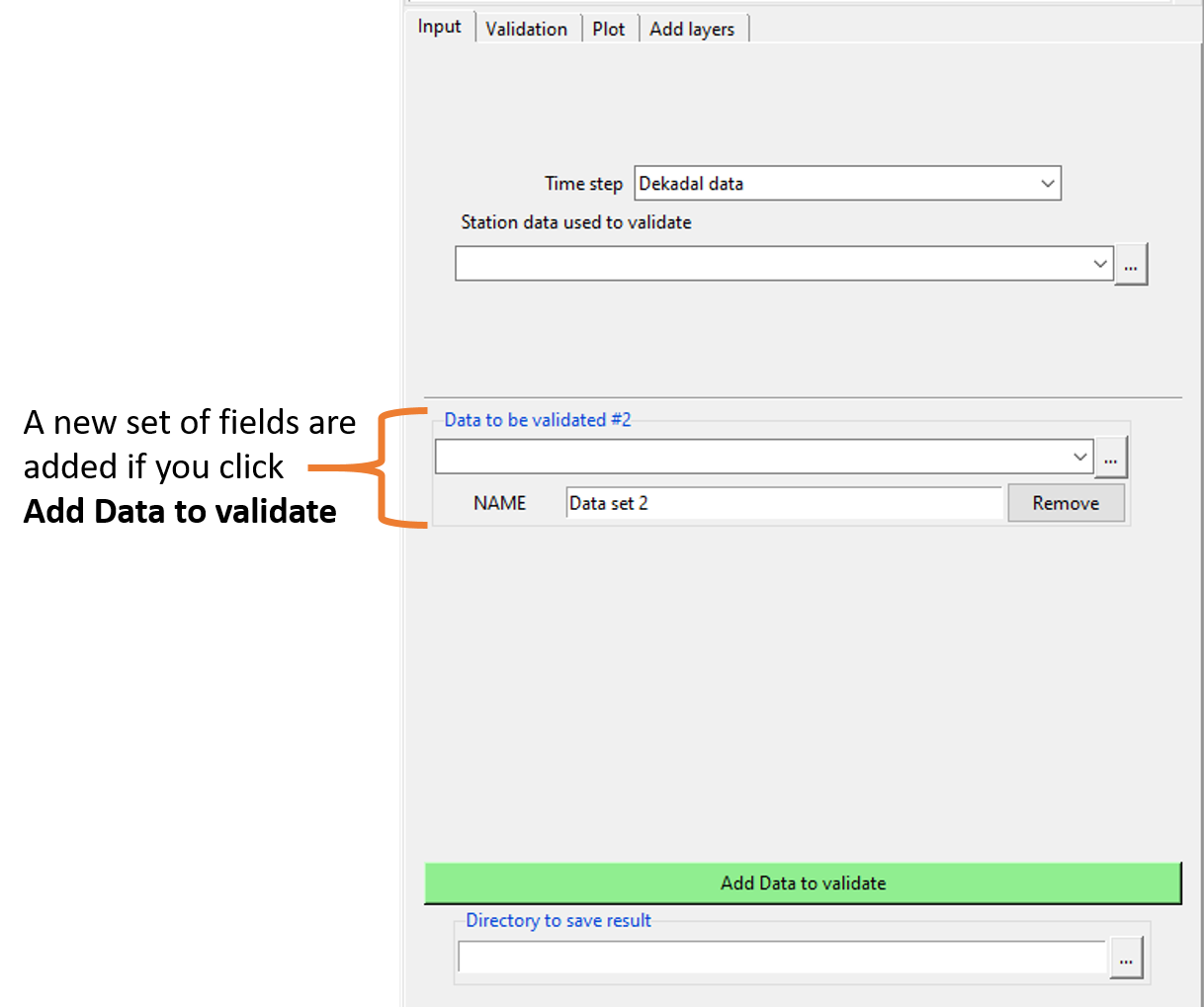
Using Validation tab, you can specify the time period of the validation and the way validation is to be performed.
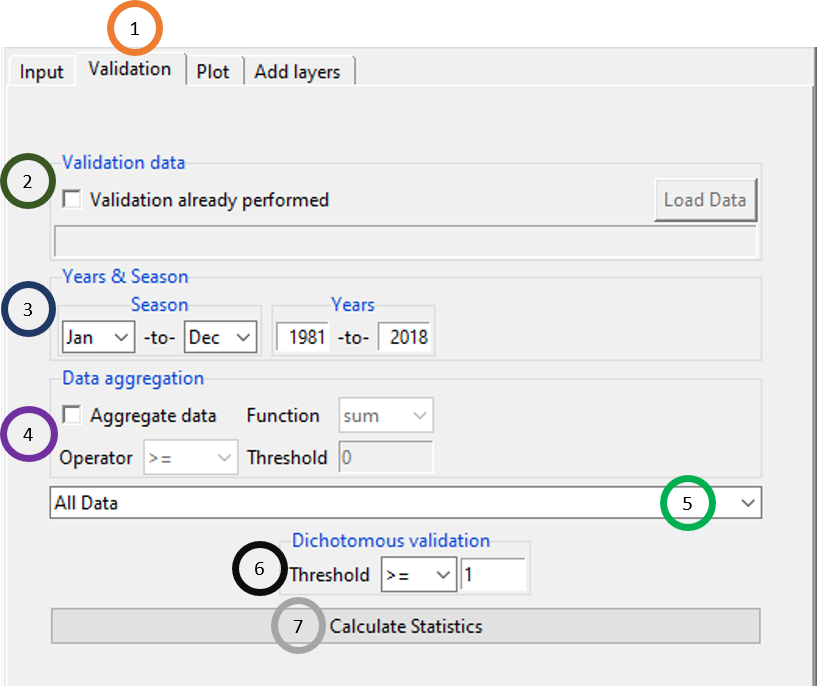
All the options under Validation tab are similar what you have seen for other Validation tabs you have seen before.
Plot and Add layers tabs also have similar set of features you have seen for other validation types you have seen here before.
5.3.2 Temperature Data
The validation for multiple data sets for temperature is very similar to precipitation and so we the description is not provided here.
5.4 References
AghaKouchak, A., Behrangi , A., Sorooshian , S., Hsu , K., and Amitai , E. (2011): Evaluation of satellite-retrieved extreme precipitation rates across the Central United States. Journal of Geophysical Research, 116, D02115, doi:10.1029/2010JD014741.
AghaKouchak, A., and Mehran , A. (2013): Extended Contingency Table: Performance Metrics for Satellite Observations and Model Simulations. Water Resources Research, doi:10.1002/wrcr.20498.